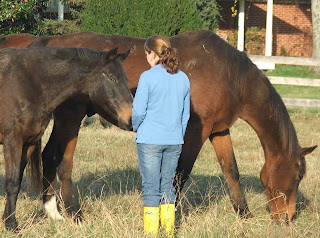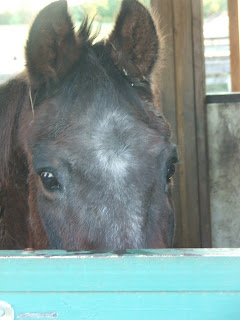Thursday, December 24, 2009
Posted by
equineelders
at
1:54 PM
0
comments
![]()
Friday, December 18, 2009
Don't visit us at Tractor Supply tomorrow!! (Sat Dec 19, 2009)
Posted by
equineelders
at
1:56 PM
0
comments
![]()
Labels: snow, Thank You, Tractor Supply, volunteer, winter
Thursday, December 17, 2009
Sherman update!
Our new man, Sherman!
This gentle ol' soul has a way to go in the weight department, but is headed in the right direction.
Posted by
equineelders
at
4:57 PM
0
comments
![]()
Labels: Sherman
Sunday, December 13, 2009
Mixed Feelings
Posted by
equineelders
at
12:57 PM
1 comments
![]()
Labels: Mona
Saturday, December 12, 2009
Infected teeth & Infected sinuses
Posted by
equineelders
at
12:31 PM
0
comments
![]()
Labels: equine dentistry, infection
Friday, December 11, 2009
Thank You, Jeanelle!
I cannot say enough about volunteers who come early on mornings like this one. "Thank you" just doesn't feel adequate.
The ground was frozen, wet bedding from the most recent flooding was frozen, poop piles were frozen..............
Thank you so much, Jeanelle, for coming out and for drying out Sherman and Henry's stalls as much as possible when everything is so completely saturated.
Jeanelle didn't quite fill Big Sam, the old JD spreader, but she came darn close and, considering the weight of the wet sawdust, we're counting it as a Golden Muck Fork Award winning day.
Round of applause!
Thursday, December 10, 2009
Herbal Insulin Resistance Treatment Options Reviewed
“Appropriate treatment for IR is controversial,” said Noble,” But the effective management of IR may prevent the crippling disease, laminitis.”
Some of these compounds are marketed for other uses, such as anti-inflammatories, anthelmintics, muscle builders, and coat conditioners. Scientific evidence demonstrating any beneficial effect of these herbs on insulin resistance in horses is lacking.
Noble and her coauthors emphasized, "The aim (of this review) is not to advise clinicians or horse owners about what to use, but to inform equine scientists contemplating research in this field."
Posted by
equineelders
at
6:53 AM
0
comments
![]()
Labels: Cushings, Insulin Resistance, IR, laminitis, PPID
Monday, December 7, 2009
A Mud-Motivated Wish List
Posted by
equineelders
at
9:04 AM
0
comments
![]()
Sunday, December 6, 2009
Horsey Snowballs
Posted by
equineelders
at
9:30 AM
0
comments
![]()
First Snow 2009
Posted by
equineelders
at
7:55 AM
0
comments
![]()
Friday, December 4, 2009
Winter Care for Elders
Posted by
equineelders
at
7:39 AM
2
comments
![]()
Labels: arthritis, blanket, feeding older horses, hay, snow, turnout, weather, winter
Tuesday, December 1, 2009
The Guardian Becomes theGuarded
Posted by
equineelders
at
8:31 AM
0
comments
![]()
Monday, November 30, 2009
Free Webcast - Dec 15, 2009 - Supplements
From My Horse University
Free Webcast: Nutritional Supplements for Horses
December 15, 2009
7:00 pm ET
Speaker: Dr. Carey A. Williams, Rutgers University
"In this hard economic environment, horse owners need to be sure they are getting the most for their money when it comes to their horse’s feeding program. Dr. Carey Williams will help demystify supplements so that you can feed your horse cost effectively with confidence. Dr. Williams will discuss a horse’s vitamin and mineral, joint, calming, herbal and various other supplements, when supplements might be beneficial, and how to use science based information to determine if your horse needs a feed supplement."
Posted by
equineelders
at
6:10 PM
0
comments
![]()
Labels: education.books, workshops
Sunday, November 29, 2009
Henry's Miracle
For more information on Reiki, see "What is (and isn't) Reiki?" (Be sure to scroll down to the Fact/Myth chart.)
Posted by
equineelders
at
8:08 AM
0
comments
![]()
Saturday, November 28, 2009
Friday, November 27, 2009
No More Donations from horse.com (formerly Country Supply)
"Searching or Shopping means a donation. It's just that free and easy. A penny or more per search, a $5 bonus for your first purchase and up to 26% of your purchases at over 730 stores like Amazon, eBay, Travelocity, Home Depot, Staples, and many, many more. Plus you SAVE money with exclusive coupons/free shipping deals."
Posted by
equineelders
at
10:07 AM
0
comments
![]()
Labels: Country Supply, donate, iGive.com
Thursday, November 26, 2009
We Are Thankful......
Posted by
equineelders
at
10:47 AM
0
comments
![]()
Labels: Dover Saddlery, equine dentistry, Equine Rescue League, Integrated Animal Therapies, Janet Dobbs, Jill Deming, Reiki, SARA, Thank You, Tractor Supply, Triple Crown, volunteer
Cushings/IR Talk, Jan12, 2010, Leesburg VA
Posted by
equineelders
at
10:05 AM
0
comments
![]()
Labels: Cushings, education.books, IR, PPID
Tuesday, November 24, 2009
Kids Today......
Posted by
equineelders
at
5:52 PM
0
comments
![]()
Labels: donate, Mona, Sherman, student project, Thank You, visit
Friday, November 20, 2009
Sherman's Rehab Plan
"Oh, sure! Before he got here, Sherman was obviously not getting much to eat, let alone getting a good diet. When he did get anything in addition to some hay, we were told it was an inexpensive general livestock grain. Usually that means a lot of whole oats, whole corn and other whole grains that an older horse can't chew and, therefore, can't digest. When he got here, he'd had very serious diarrhea for some time.
For his first meal, he got half a flake of grass hay. No senior feed right then. At the next meal, he was offered 2 cups of Triple Crown senior feed, soaked, then another half flake of hay. (He is given senior feed in four small meals during the day.) The next day, we gave him a whole flake of hay at a time since he didn't seem to be wolfing it down. On the third day, we began slowly increasing the portion of senior feed and introducing small handfuls of soaked alfalfa cubes.
The only thing we added to the hay and senior feed to this point was some ProBios. In general, unless recommended by the vet, we try not to introduce a lot of new things to a gut that's already in an uproar. After about 5-6 days, the diarrhea was more of an intermittent problem rather than a constant issue, then we figured out that some of the hay had clover in it and that seemed to be what he was sensitive to.
We eliminated the clover and started adding Accel (thank you, Dover Saddlery!) to two meals a day since it contains probiotic ingredients. That seemed to do the trick, and though Sherman occasionally has softer manure than normal, its still well formed and not a major concern at this point.
Right now, Sherman is eating four meals a day, each consisting of 2-1/4 qt of senior feed and 1-1/2 qt of alfalfa, free choice grass hay and Accel 2x/day. Since he does still have some soft manure now and then, we're going to be very cautious introducing him to grass. We'll probably continue to increase his feed portions until he's getting 3 quarts 4x/day and maintain that diet until he regains the weight he needs.
Keep in mind that this is a customized Sherman Rehab Plan. We have a general outline we follow for each horse, but the details are always different."
Posted by
equineelders
at
7:13 AM
0
comments
![]()
Labels: Dover Saddlery, feeding older horses, rehab, Sherman
Thursday, November 19, 2009
Does This Look Odd To You?
Posted by
equineelders
at
3:30 PM
1 comments
![]()
Labels: Nathan
Wednesday, November 18, 2009
Today's Anatomy Trivia
Posted by
equineelders
at
7:46 PM
0
comments
![]()
Tuesday, November 17, 2009
Sherman's First Farrier Visit
Posted by
equineelders
at
6:50 PM
0
comments
![]()
Labels: Sherman
Monday, November 16, 2009
Wednesday, November 11, 2009
Extra cleanup this weekend
Once the "remnants" of Tropical Storm Ida depart, the horses say they MAY venture out of their sheds. Anyone with an extra hour or two to spare, Fri, Sat, or Sun would be very very much appreciated. (And you get to meet Sherman!)
Woman charged with cruelty to polo ponies dies
Posted by
equineelders
at
12:52 PM
0
comments
![]()
Labels: Mona
Cushings horses: Use topicals with care!
"We were really surprised to see such massive systemic changes in such a short time," Abraham said. "And this was in healthy horses.
The study, "Effects of dermal dexamethasone application on ACTH and both basal and ACTH-stimulated cortisol concentration in normal horses," was published in the August 2009 Journal of Veterinary Pharmacology and Therapeutics.
Posted by
equineelders
at
9:52 AM
0
comments
![]()
Don't Freeze Your Manure!
Posted by
equineelders
at
8:54 AM
0
comments
![]()
Labels: manure management, pest control, worms
Tuesday, November 10, 2009
Drum Roll, Please!
Monday, November 9, 2009
TREES' Cushings Club
Sunday, November 8, 2009
Santa's Elves Sneakin' Around
Saturday, November 7, 2009
Final update on the "Trial for Mona"
The defendant in the "Polo Pony Retirement Foundation Case" passed away on November 4, 2009. There will be no trial.
Posted by
equineelders
at
8:35 PM
0
comments
![]()
Labels: Mona
Senior Spa Day!
Fitz, 26, absolutely ate up the extra attention, looking like he might take a nap during his grooming session:



















































